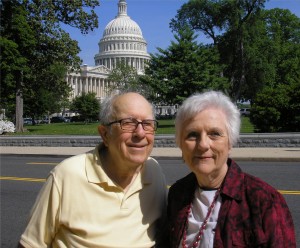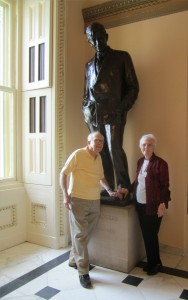By Bob and Mary Haught
Washington, D.C., was our workplace for more than 20 years. We find the nation’s capital to be beautiful and exciting, and there’s never enough time to enjoy all of its attractions. Here’s a guide to what you can see and do, as time permits, while you’re here for the conference:
White House and The Mall — The Executive Mansion is the official residence and principal working headquarters of the President of the United States. Self-guided tours are available from 7:30 to 11:30 a.m. Tuesday through Thursday, 7:30 to 1:30 p.m. Friday and Saturday. Tour requests must be submitted through one’s Member of Congress, no less than 21 days in advance. The Mall is a national park stretching 1.9 miles from the Capitol to the Lincoln Memorial. It receives approximately 24 million visitors a year. Free.
Capitol Hill — Principal feature of this historic neighborhood is the Capitol, home of the U.S. Congress. Entrance is through the Capitol Visitor Center, located beneath the East Front plaza at First Street and East Capitol Street. It is open to visitors from 8:30 a.m. to 4:30 p.m. Monday through Saturday and tours are conducted during those hours. Tours may be booked in advance at www.visitthecapitol.gov. Do this on free time.
On Friday evening the Center will be closed to the public and no tours available. House Speaker John Boehner, R-Ohio, has granted our request to go to the Will Rogers statue in small groups escorted by state members from the office of Rep. Markwayne Mullin, R-Oklahoma. Senate and House galleries normally are open to visitors, but Congress will not be in session during the time of the conference.https://www.columnists.com/wp-admin/post.php?post=17867&action=edit&message=9
Other landmarks on “The Hill” are the Library of Congress and the Supreme Court, both across First Street from the Capitol and the Botanic Garden, off the West Front lawn. Free.
If you didn’t travel by train it would be worth your while to walk through the beautiful grounds north to admire the 107-year-old Union Station, which has shops and eating places. Free.
Museums — Foremost is the Smithsonian Institution (not institute), which is not one museum but many, including the National Zoo. Most popular are the American History Museum, the Arts and Industries Building, the Natural History Museum and the Air and Space Museum. The most recent addition to the complex is the American Indian Museum. The African American Museum is under construction. Most of these are free and open every day of the year.
Others include the National Building Museum, the Holocaust Museum, the Spy Museum, the Crime Museum, the National Geographic Museum, the National Archives and the Newseum (the latter two on Pennsylvania Avenue).
Art Galleries and Museums — Under the Smithsonian umbrella are the American Art Museum, the National Portrait Gallery, the Sackler/Freer Galleries, the Renwick Gallery, the African Art Museum, and the Hirshhorn Museum and Sculpture Garden. Others include the National Gallery of Art, the Phillips Collection, and the Corcoran Museum (to be divided between the National Gallery and George Washington University).
Monuments and Memorials — Conference attendees will be happy to see the Washington Monument has been reopened following repairs to damage from the 2011 earthquake. The ugly scaffolding is down, and it stands in all its glory as the tallest structure in this low-rise city. New monuments and memorials are being added year by year, but these are some of the ones most visited: the Lincoln Memorial, the Jefferson Memorial, and memorials honoring veterans of World War II, the Korean War, and Vietnam, as well as Franklin D. Roosevelt and Martin Luther King, Jr. Tip: You might want to see these as part of an on-and-off sightseeing tour that also will take you to the Arlington National Cemetery. A good photo-op (and column idea) is the Temperance Fountain and statue at Seventh Street and Indiana Avenue N.W. (formerly on Pennsylvania Avenue).
Theaters — Washington has an abundance of cultural attractions, including the following: John F. Kennedy Center for the Performing Arts (Kennedy Center) staging June 14-July 13 Side Show then June 17-Aug. 17 The Lion King; The National Theatre (dark); Warner Theatre (between Broadway productions); Arena Stage June 6-29 Healing Wars (dance); Shakespeare Theatre Company Lansburgh Theatre May 29-July 13 Noel Coward’s “Private Lives”; Ford’s Theatre June 25-July 5 One Destiny; (Ford’s also has a tour of the historic theater and the house where Lincoln died and an excellent museum).
Churches — Probably the best known are Washington National Cathedral, sometimes called “the spiritual home for the nation” because of its televised services for heads of state; St. John’s Episcopal at Lafayette Square, known as “the Church of the Presidents”; New York Avenue Presbyterian, which also has a history of attendance by presidents because of its proximity to the White House; and Basilica of the National Shrine of the Immaculate Conception, the largest Roman Catholic church in the United States and North America.
For more information about any of the above, use the Internet. Tip: Get a copy of the Friday, June 27, Washington Post and see its Weekend Section for up-to-date listings of events.
Get familiar with Washington’s Metro system, because many of the above are on one of the lines. If you have a car, we recommend a trip south on the George Washington Parkway to Old Town Alexandria, where historical figures like George Washington and Robert E. Lee trod the brick sidewalks and cobblestone streets (it’s our former residence). Farther south is Mount Vernon.

Here’s Bob and Mary Haught on location near the Capitol. Not as tourists but insiders, having worked in the District as well as being longtime residents
— well, nearby Virginia.
Refer to Zagat’s or other sources for dining recommendations. Some of our favorite restaurants that have stood the test of time include: Old Ebbitt Grill (“the oldest saloon in Washington”), Billy Martin’s Tavern in Georgetown, The Monocle on D Street N.E. (on the Senate side of the Capitol; the Tune Inn (burgers) on Pennsylvania Avenue S.E. (on the House side), the Occidental Grill and Restaurant and the National Press Club Fourth Estate dining room (open to public). With sad memories of Blackies’ House of Beef, The Market Inn, Jenkins Hill, Hawk ‘n Dove and Harvey’s, to mention a few that are no more.
Tip: If you are a member of a press club, bring your card. The National Press Club has reciprocity privileges for most other clubs.
Tip: A nice photo-op downtown walking tour: from Metro Center subway station go south on 13th St. to Pennsylvania Ave. You’ll see the Old Post Office and Clock Tower (which is closed for renovation by Donald Trump into a luxury hotel). Go west to 14th, then north past the J.W. Marriott to the National Press Building. Take elevator to 14th floor and ask to see the Ernie Pyle display. Back down to 14th (there’s a handy liquor store) cross the street to the Willard hotel. Enter the lobby and see all the state seals on the ceiling. It’s where President Ulysses S. Grant cursed the “damned lobbyists” who pestered him, and the site of the Round Robin bar where Sen. Henry Clay of Kentucky introduced the mint julep to Washington. Walk through the hotel’s “Peacock Alley” area of shops to F Street and turn left. Continue past the W Hotel and the Treasury Department to the White House (plenty of good camera angles) and if there’s a vacant bench relax in Lafayette Park until you’re ready to move on. The Farragut North Metro stop is about three blocks northwest on K Street. (past G, H and I – sometimes spelled Eye. Don’t look for J. There is no such street.)
• • •
Robert L. “Bob” Haught is a longtime member and former officer of the National Society of Newspaper Columnists, retired from The Oklahoman, for which he was based in Washington. Mary Haught, with her sweet demeanor not quite masking a quick wit, is familiar to attendees of many years of NSNC conferences. Read his blog Haughtline Dweethly.
This column originally was published in the June 2014 edition of The Columnist, the members’ newsletter of the National Society of Newspaper Columnists.


